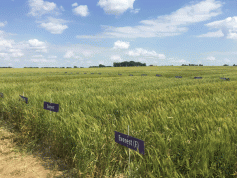Breadcrumb
- Home
- Make an informed decision when selecting the best wheat variety
In recent years, wheat producers are faced with an increasing number of varieties from which to choose. Producers can use different tools and publications to study each variety’s strengths and weaknesses, selecting varieties that best match their needs.

Figure 1. Producers in Kansas have many wheat varieties to evaluate. Photo by Romulo Lollato, K-State Research and Extension.
The following information provides a step-by-step guideline, as well as relevant resources, to help producers make a better decision when selecting one or a few varieties to plant in their operation.
Regardless whether you intend to plant one variety or several on your farm, it is important to start out with a list of several good candidate varieties. The final product of interest is grain yield and therefore, it is crucial to select varieties that have shown consistent performance and excellent yield record in the region. Varieties that worked well for you and your neighbors in the past should be considered, but also make sure and check yield results from nearby K-State (and other universities’) variety performance tests and demonstration plots. It is important to take into consideration the conditions experienced during the year in question, and always look for trial results from past years as well, due to the high year-to-year variability in weather conditions in Kansas. Beyond looking at results from more than a single year, checking for variety performance in several nearby locations is also a good practice.
A few great resources to consult are:
After selecting several varieties that have shown good adaptability and stability in your region, the list needs to be narrowed down to the number of varieties you intend to plant. Ideally, at least two or three varieties (or a blend of two or three varieties) should be planted to spread the risk on your acres. Select varieties that are adapted and resistant/tolerant to the major concerns in your region, but that have contrasting characteristics such as different maturities or disease resistance characteristics. This will help buffer the risk of a single event compromising production of the whole operation and can help spreading out harvest dates so not all varieties are ready at the same time. Some factors to consider include:
A few great resources to help you walk through each variety’s characteristics as far as maturity, disease ratings, drought and soil pH tolerance, date of first hollow stem, and other agronomic characteristics are:
Romulo Lollato, Wheat and Forages Specialist
lollato@ksu.edu
Erick DeWolf, Plant Pathologist
dewolf1@ksu.edu
Kelsey Andersen Onofre, Extension Wheat Pathologist
andersenk@ksu.edu
Originally published at https://webapp.agron.ksu.edu/agr_social/article_new/make-an-informed-decision-when-selecting-the-best-wheat-variety-402-2
Wheat Rx is a combination of suggested management practices for economical and sustainable production of high-quality winter wheat in Kansas.
